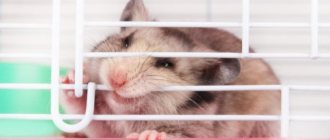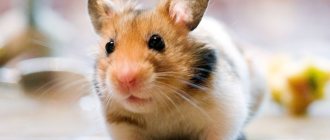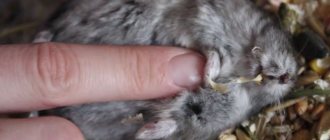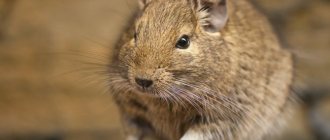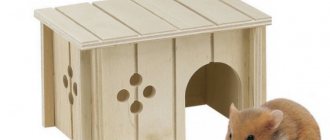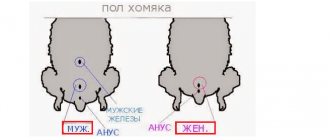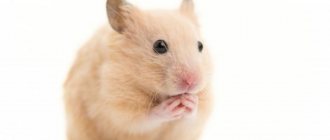- home
- Kinds
31.03.2018
A small, nimble, cheerful and active creature is a representative of the dwarf rodent species Campbell's hamster. This baby will bring his owners a lot of joy, he is unpretentious in daily maintenance and does not require special care. However, some rules of keeping and feeding will have to be strictly followed.
Characteristics of the Campbell hamster
| How long do Campbell hamsters live? | The lifespan of different individuals varies quite greatly. On average, a rodent lives from 1 to 2 years. At home, with proper care, a hamster can live longer. The maximum lifespan is up to 4 years. |
| Breed color options | The most common:
The classic color of wild and most domestic species is agouti. In captivity, many representatives of the breed were bred with a wide variety of colors: from white (albino) to black, spotted, tortoiseshell, silver, satin and many others. |
| How to stop a Campbell hamster from biting? | This subspecies is considered the most problematic in domestication. Be patient and be gentle with the animal. Biting is not just aggression. It is necessarily caused by one of the following reasons, which must be avoided:
In any case, hamster bites, although painful, are not dangerous. Treat the wound with hydrogen peroxide or brilliant green. You cannot scold, let alone shout at your pet. He is not stupid at all and is able to remember this for the rest of his life. Then you will definitely not be able to make friends with the rodent. |
| How to choose the right pet? | It is better to purchase a Campbell hamster from a nursery or from a reputable breeder. Do not buy or take for nothing a sick animal, even if you feel sorry for it. This will only bring frustration to you and your family who has become attached to the pet. There is no need to purchase a rodent that is too old or, conversely, young. The best age is no younger than 3 weeks and no older than 3 months. When purchasing, pay attention to:
Tip: males are much calmer and easier to tame than females. The first thing you need to do after purchasing, especially if the animal was purchased for children, is to show it to the veterinarian. Remember that ordinary dwarf hamsters are often passed off as Campbell hamsters. Therefore, carefully study their differences. |
| How to distinguish a Campbell hamster from a dwarf hamster? | The Campbell hamster in the photo and in life is very similar in appearance to the popular Djungarian hamster. They can be distinguished by the following criteria:
|
| How much does a dwarf rodent cost? | On the domestic market, the price of a Campbell hamster ranges on average from 150 to 300 rubles per individual. |
Advantages of keeping the species:
- Attractive appearance.
- Small size: does not require a large cage or large food expenses.
- There is no unpleasant odor even if there are errors in the content.
- Does not require much attention: loves to be alone, which is convenient for busy owners.
Difficulties in keeping a hamster:
- It is difficult to comply with the conditions for keeping in a group.
- Not suitable for children under 12 years of age.
- A difficult and long process of taming.
- Aggressive: often bites and does not give in to hands. Some especially restive individuals have to be handled only with special gloves.
- It is nocturnal, so it makes noise at night.
- Does not tolerate change of environment well.
The Campbell hamster is considered the most aggressive of the dwarf breeds. It is very difficult to tame or at least gain trust. Khomka does not like it when people pick him up and try to get into his home. Expresses dissatisfaction with attacks and painful bites. The subspecies is more suitable for observing the life of hamsters from the outside.
Appearance and habits
Representatives of this breed got their name in 1904 in honor of the explorer Charles Campbell, who brought the animals to Europe from the Chinese-Russian border. Outwardly, these hamsters are very similar to Dzungarian rodents; for some time they were even considered a subspecies of Djungarian rodents, but then everything fell into place.
Campbell's hamsters differ from their relatives in their golden (amber, brown) coats (Djungarian hamsters have lighter coats). They also have small ears and reddish eyes. Like dwarf hamsters, Campbell's hamsters have a dark stripe on their backs, only it does not form a diamond closer to the head, but is even from start to finish. If you look at the “fluffy” from above, the Djungarian hamster’s body shape resembles an egg, and the Campbell’s hamster has the shape of a figure eight.
Several decorative colors of the breed have been artificially bred in nurseries: agouti (sand-gray), self (sand color with white spots), silver, satin, black and white hamster. The fur of this breed sticks out upward and resembles tufts; it is even present on the “soles” of its paws. You can see what it looks like in the photo.
Rodents of this breed grow to a maximum of 10 centimeters, and even an adult hamster weighs no more than 50 grams. The length of the tail is about 14 millimeters, the muzzle tapers towards the end. The front legs have 4 toes, and the hind legs have 5.
In the wild, Campbell's hamsters live in the desert places of Kazakhstan, China, Turkmenistan and Mongolia; they can also be found in the vast expanses of Russia in Tuva, Buryatia and Transbaikalia. These rodents prefer to live in pairs or small colonies with a leader at the head. The animals prefer a nocturnal lifestyle, do not hibernate and do not change the color of their fur coat before the arrival of cold weather. They take refuge in burrows up to 1 meter deep, which are lined with wool, leaves and dry grass.
Campbell's hamsters have poor vision, but have an excellent sense of smell and hearing. They feel good alone and will not suffer because the owner is constantly busy with other things.
and care
In Europe and America, the Campbell hamster is the most popular breed of rodent. There, this subspecies displaced even the ubiquitous Dzungarians and Syrians. In Russia, the breed is not so in demand. Although, caring for a Campbell hamster is quite simple.
Some experts argue that in captivity, rodents can live, as in the wild, in small groups, but only on the condition that this “social unit” has been formed from a very young age. If you combine several adults in one cage, they will fight mercilessly and never get along. Relatives separated for a while and then returned to the same territory will behave just as aggressively. Even if one of the family members “goes for a walk” around the apartment and returns after a while, a fight cannot be avoided.
Another point of view is that the Campbell hamster can only be kept alone, like all other subspecies except the Roborovsky. When kept together, hamsters will fight and injure each other until one of the individuals dies.
Cage, aquarium
Since the breed is dwarf, a cage or aquarium measuring 40*60 cm is suitable for a hamster. This is the minimum territory for one individual. Give preference to horizontal rods. Rodents love to climb on them.
The bottom of the home must be filled with sawdust or any other filler from a pet store. This will avoid unpleasant odors if you clean only once every 1 to 2 weeks.
You must choose a bright place for the cage, but not in direct sunlight or in a draft, away from the radiator and other heating devices. It is better to choose a place for your home away from the bedrooms, otherwise the hamster, which is active at night, will interfere with your sleep. Also make sure that there are no objects near the cage that the rodent can reach and drag away or chew. Keep your pet safe from attacks from other pets. A cat can easily pull a small hamster out of its cage and eat it.
An important nuance of keeping dwarf hamsters is that they can easily squeeze between the bars of the cage due to their tiny size. To avoid this, you can purchase a special cage with frequent rods (with a distance of 0.5 cm), or use a terrarium or aquarium made of glass or plastic.
Feeder, drinking bowl, house
In the hamster's home you need to install a feeder, a drinking bowl and a house. Choose a heavier feeder: made of stone or ceramic, so that the hamster cannot knock it over and clog the cage again. You can use any suitable container for the feeder, such as a jar lid, but this is completely unaesthetic. The drinking bowl must be changed once a day. The animal should always have access to fresh, clean and cool water. It is more practical to choose an automatic drinker; it keeps the water fresh longer and cannot be knocked over. The house can be made of any material, but it is better to give preference to plastic. A wooden house will quickly be rendered unusable by the teeth of a hamster. The hamster organizes the nest in the house himself. Offer him napkins and soft hay for this. Rags or newspapers should not be placed in the cage: the first material often gets tangled and injured the hamster’s miniature legs, the second contains poisonous printing ink. In principle, the house is not necessary, but hamsters like to stay in it and hide their supplies there. In addition to these attributes, the rodent will need a running wheel with a solid surface to avoid injury to its paws. The larger its size, the better. Without a wheel, the hamster will be inactive and begin to suffer from obesity, which will shorten its lifespan.
You can install a toilet tray in the corner of the cage, but this is also not necessary. It is important to install a sand bath for bathing - plastic, glass or ceramic. It is better to buy sand for bathing; there is sand for chinchillas on sale, which is perfect. Sand from the street can contain dangerous bacteria. Under no circumstances should you bathe your pet in water. He could catch a bad cold and die.
You will definitely need a chalk stone on which your pet will grind his teeth.
Cleaning
You need to clean your home no more than once a week. After cleaning, pour a handful of “old” litter into the cage. It is very stressful for rodents when there is no native smell left in the cage. Very rarely, once every few months, you can thoroughly wash the cage using detergents such as soda. The use of chemicals is not recommended.
Walks
At least sometimes it is necessary to let your pet out of the cage so that he can run around. Walks should be carried out very carefully; you should not let your hamster roam freely around the apartment. It is better to purchase a special walking ball for this purpose or make a kind of enclosure. It is strictly forbidden to let your hamster outside: he may catch a cold, get lost, or become infected with some disease.
The Campbell hamster's tricks with its body temperature are curious: during night activity, the temperature rises to 40 °C. At rest, during the daytime, when the rodent is in its nest, the body temperature drops to 20 °C. Scientists explain this phenomenon by saving the body’s strength and resources.
Another interesting fact is that hamsters see everything in black and white, but they have very poor eyesight.
Cell selection
Considering that the Campbell hamster is a dwarf breed, it is kept in small structures. For one individual, a cage with dimensions of 40 x 60 cm is sufficient. It is better if the cage is constructed of horizontal rods. Rodents love to climb up them, thus exercising.
The bottom of the housing is filled with any filler sold in pet stores specifically for hamsters. The best environmentally friendly material is sawdust. When cleaning the cage, after 7-10 days there will be no unpleasant odor from the insect.
It is recommended to keep pets in a room where there are no drafts. The cage is installed in a bright place, but not in direct sun. As for the night time, this active rodent, like the Djungarian, is very noisy, so when twilight comes, it should be placed away from the bedroom.
Another important point is that hamsters of this breed manage to crawl through the bars of the structure, so a cage with thick bars is used to prevent their escape.
If there is a cat or dog in the house, you need to provide the dwarf pet with maximum protection from them. The cage must be in a place inaccessible to animals.
Cleaning the cage
Home cleaning is carried out no more than once a week. This is enough to keep the rodent's house clean and prevent the development of harmful microflora. After each cleaning, the bottom of the cage is filled with new filler. Thoroughly wash the drinker, feeder and wheel, which can be easily removed.
When cleaning the cage, you should not use chemicals, as they are toxic and very dangerous to the health of the rodent. Sometimes you can wash the cage with baking soda no more than once a month.
Feeding
The question of what to feed your hamster is very important. Its appearance, activity, health and life expectancy depend on this. Despite being unpretentious in care, the rodent requires a balanced and varied diet. The daily menu must include seasonal fruits and vegetables or dried fruits, herbs, grain mixtures that can be purchased at a pet store, nuts, pumpkin, watermelon or sunflower seeds.
All types of food necessary for a hamster can be divided into several categories:
Hard food
You can prepare the mixture yourself or purchase it ready-made at a specialized pet store. The composition usually includes sunflower seeds, nuts, peas, corn, oats, wheat, buckwheat. Ready-made food must be supplemented with vitamin supplements necessary for full growth and development. Feed mixtures can be made in the form of a stick with grains stuck on it. An additional advantage of this diet is that the hamster can grind down its teeth while eating.
Fresh food
The healthiest greens are lettuce and dandelion leaves, dill, parsley, clover. Sprouted wheat contains many vitamins. As for vegetables, you should regularly eat carrots, pumpkin, beets, zucchini, cucumbers, pattison, potatoes, and corn. From fruits and berries - bananas, apples, pears, peaches, raisins, grapes, raspberries, strawberries, watermelon. Hamsters' favorite cereals are peas, lentils, and beans.
Ears and branches
Dried ears of wheat and oats, twigs of cherry, apple, and birch.
Animal proteins
Small beef bones, chicken (lean and unsalted), boiled fish and liver, low-fat cottage cheese, milk, yogurt, low-fat cheese, oatmeal or semolina porridge with milk - once or twice a week. Special food insects from a pet store - as a treat.
Vitamins and minerals
First of all, it is a mineral stone, which contains chalk and salt necessary for the hamster’s body. Additional vitamins are also needed, especially during the cold season, when there is not a wide variety of fruits and vegetables, during pregnancy or while nursing babies. Vitamins can be purchased at a pet store. They are usually made in the form of small pellets that can be crushed and the resulting powder sprinkled on food. It is useful to give hamsters 0.2 g of fish oil daily. You can buy pharmacy vitamins A, E, C or D in ampoules and add a drop to your food once a week. Vitamins for humans are strictly contraindicated for hamsters.
Additional Products
Oatmeal, special cookies and biscuits for hamsters, rye crackers.
Water
Water for rodents should be boiled, filtered or specially bottled.
The animal should eat about 5 times a day, but in small portions. If the hamster stores, this does not mean that it is malnourished and needs to increase the amount of its diet. This is a normal instinct of a wild animal. Supplies should be periodically removed from hiding places in the cage, but do not eliminate them entirely. This is a lot of stress for thrifty animals.
Products prohibited for hamsters:
- Food from the human table.
- Salty, spicy, smoked, sweet, fried.
- Cabbage and tomatoes.
- Citrus and kiwi.
- Pine nuts.
- Peanut.
- Almond.
- Cocoa.
- Fruit seeds and seeds.
- Persimmon.
- Onion and garlic.
Comfortable pet life
For excellent health, an animal does not need much: a spacious cage, several accessories for an active lifestyle, regular drinking, balanced food and cleanliness.
Torn paper or napkins or sawdust can be used as filler for the cage. As well as a specialized mixture that can be bought at any pet store. But cotton wool, threads and rags are unlikely to be appropriate for filling the cage - the animal’s paws can easily get tangled, which will lead to injuries.
Hamsters' teeth grow throughout their lives, so the animal should be given solid food, and also make sure that the cage contains some kind of accessory designed for grinding down the front incisors.
Reproduction
Reproduction of the Campbell hamster occurs from March to September, sometimes the timing can shift by a month in one direction or the other. During a season, a female can give birth up to 4 times. It is necessary to select individuals under one year of age as parents. After a year, females’ pelvic bones become ossified and it is more difficult for them to give birth to large cubs. Both partners must be absolutely healthy, active, with shiny fur, well-fed, but without signs of obesity. Only in this case can you expect a healthy offspring.
Females should be covered no earlier than three months of age. Until this time, the female does not have enough milk to feed her offspring. A few days before the “romantic date,” the future parents need to be introduced. To do this, animal cages are placed close to each other or they are put in one cage, but separated by a mesh fence. Individuals will be able to sniff and get used to each other, but at the same time they will not be able to harm their partner.
The male must be separated from the pregnant female during pregnancy and feeding the offspring, otherwise the hamsters will fight. A pregnant hamster should increase the proportion of animal protein and vitamins in her diet, and do a thorough cleaning of the cage a few days before giving birth, since after giving birth the hamsters cannot be disturbed. You should purchase a house for the offspring in advance, a regular one may be small, and material to build a cozy nest. Down, sawdust, toilet paper, soft hay, soft napkins or special filler from a pet store are suitable. You can use a regular cardboard box as a house and then just throw it away.
The gestation period for cubs varies from 15 to 21 days. After giving birth, you should be very careful to make sure that everything is fine with the mother and her children. If there are dead hamsters, they should be carefully removed from the nest; they are a source of bacteria. Live cubs that fall out of the house should be sent back without the use of hands, better than an ordinary teaspoon.
Already on the 5th day after birth, hamsters begin to develop fur, and at 10 days they open their eyes. Twenty-day-old individuals can be safely removed from their parents.
Before the female begins to hatch offspring from the nest, it is better not to pick up or even touch the hamsters. The mother may not accept a baby that smells like a human.
It is possible to cross a Campbell hamster with a Djungarian hamster. There are many such hybrid hamsters in unscrupulous pet stores. Of course, if such an animal was acquired out of ignorance, you will not love it any less. What difference does it make that some of the genes were inherited from another breed? But such incest should not be allowed on purpose.
This is primarily due to difficulties during childbirth: it is very difficult for a female dzhungarika crossed with a Campbell to give birth to a large baby. She might die. Plus, Campbell hamsters are extremely susceptible to diabetes, which will be inherited by the young at the genetic level. Another drawback is that “contamination of the gene pool” will not allow participation in exhibitions. Even if you are admitted to them, you should not expect high marks.
It is also not recommended to create a pair of closely related hamsters. The offspring will inherit a lot of genetic defects and pathologies. The same principle should be followed if hamsters have a particularly aggressive character: it will certainly be passed on to their descendants.
Campbell's hamster diseases
Signs that your hamster is sick:
- Cloudy eyes with discharge.
- Decreased activity.
- Wet fur around the tail or belly area.
- Hair loss or scratching on the skin.
- Weight loss.
- Sniffling and sneezing.
- Diarrhea.
- Nasal discharge.
- Refusal of food.
Most often, Campbell hamsters are susceptible to the following diseases:
- Proliferative ileitis is a severe and highly contagious infectious disease, popularly called “wet tail”. Symptoms: diarrhea, bloating, wet fur around the anus, loss of appetite, unpleasant odor. Often leads to the death of the pet.
- Diarrhea – usually caused by improper feeding, antibiotics or infection.
- Conjunctivitis - it is usually caused by microtrauma to the eyes: particles of hay, sawdust getting into them, failure to comply with the hygienic conditions of keeping the hamster. Symptoms include discharge from the eyes, sticky eyelids, and the rodent constantly scratches its face.
- Hair loss is caused by many diseases, many of which are transmitted to humans: dermatophytosis, lichen. Often the reason lies in parasites: demodex mites. A sick animal can transmit them to a healthy one.
- Lymphocytic choriomeningitis (acute Armstrong serous meningitis) is an extremely contagious and transmissible acute viral infection that affects the brain and central nervous system.
- Glaucoma is a very common disease in the breed, characterized by high eye pressure. It proceeds as follows: the eye increases in size and then bursts, the eyelid grows together as it heals. The disease has no cure.
- Eczema - usually manifests itself as an allergy to some material or filler from the cage, typical of old individuals, and animals with weak immunity or those that have experienced stress.
- Diabetes is a genetic disease characterized by increased thirst and frequent urination. The disease is incurable; only diet and treatment using insulin, which can only be prescribed by a doctor, will temporarily help. An overdose of insulin will cause the death of the animal.
- Tumors are common in older individuals and can be malignant or benign. They are treated with surgery, but each individual case must be considered separately: often a young hamster with a tumor can live longer than after surgery. Sometimes it is more humane to euthanize your pet.
- Polycystic disease is a genetic disease with no cure. The hamster's abdomen swells, he stops cleaning himself, drinks a lot and lies motionless.
A veterinary specialist, a ratologist, deals with the health of hamsters and other rodents. The physiology of these animals is significantly different from the organisms of dogs, cats and other pets, so an ordinary veterinarian will not be able to properly treat rodents.
